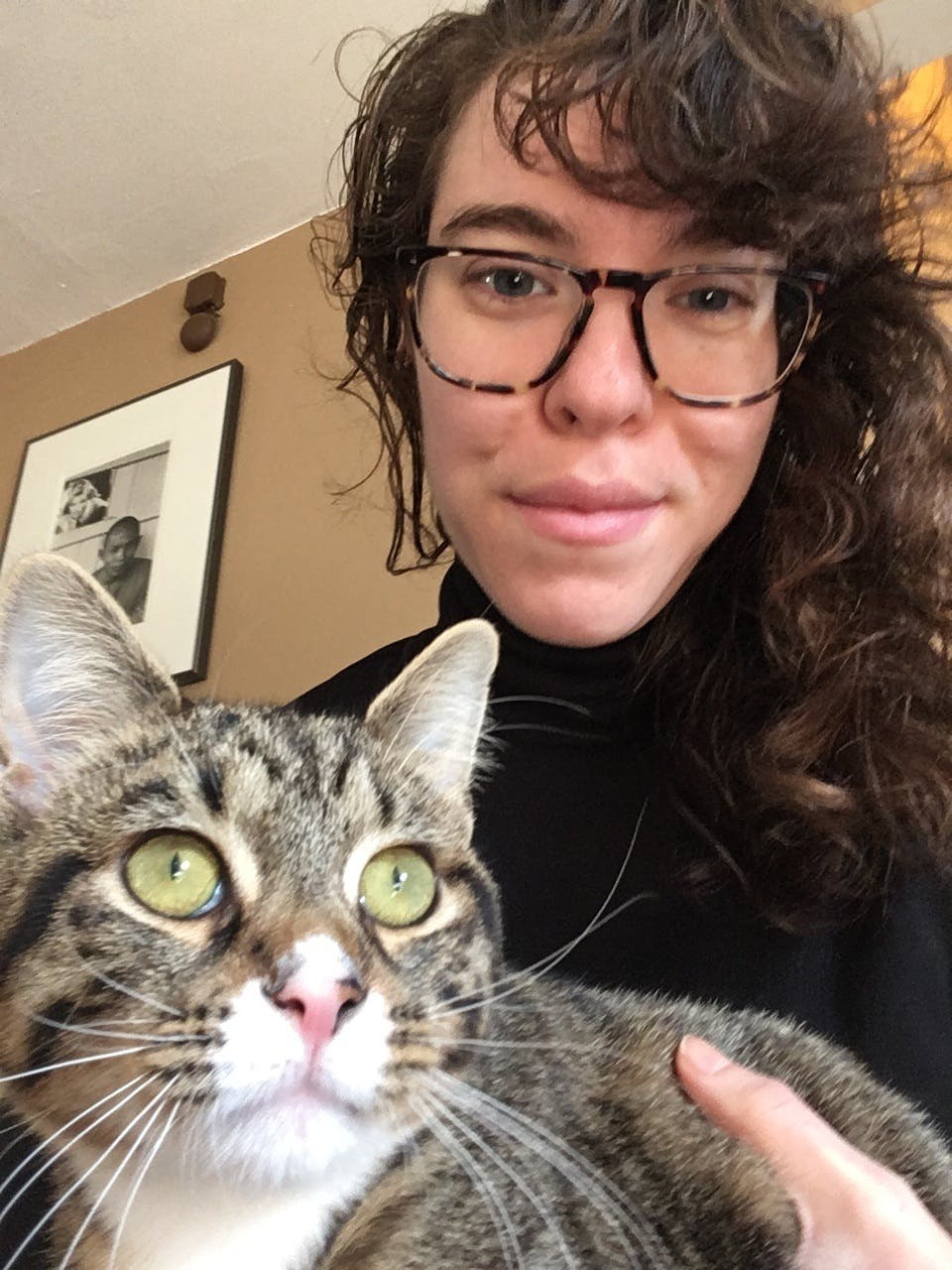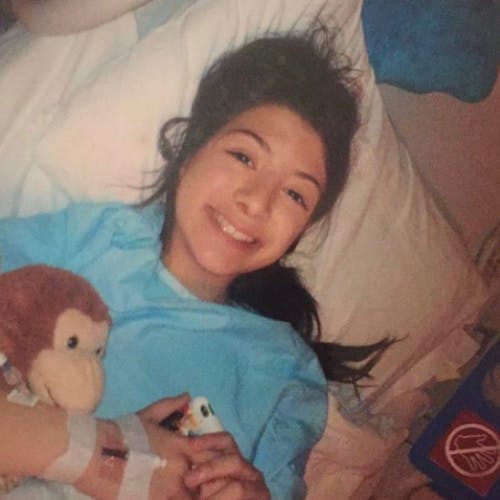
Moving forward after chordoma
If having chordoma is like being a wombat — a rare species seldom seen in the wild — having chordoma as a child or young adult is like being a hairy-nosed wombat1 — a uniquely uncommon breed in an already rare class. At any given time, fewer than one in 100,000 people worldwide live with chordoma, and less than five percent are children or young adults. So, finding support and camaraderie from someone who relates to your experiences can be invaluable.
For Alex Casanave, Julia Lisena, and Emily Sommer, the journey from diagnosis to survivorship was different, but the experience was similar. And it led them all to support other young patients and families through our Peer Connect program, as Peer Guides (Alex and Julia) and trainees (Emily).
All three shared common challenges such as having their initial symptoms dismissed by their primary care physicians, navigating tricky relationship dynamics with friends and family at the same time they were navigating treatment, and struggling to plan ahead while everyone around them was looking to the future. They also found comfort in similar places, including young adult support groups, therapy, and being of service to other young people navigating chordoma. Here are their stories, and the advice they share with others.
Alex’s story: Planning for the future
Alex Casanave was diagnosed with chordoma at the age of 23. Just a few years out of college, she was working as a nanny in New York City and studying nursing. Her symptoms came on gradually, and it took a while before she connected them together and brought them up to her doctor. It began with a tingly feeling in her fingers and decreasing energy levels. Then, she started losing weight and noticing issues with her balance, tripping and falling when she usually wouldn’t. Finally, when her handwriting suffered because of how difficult it was for her to grip a pen, she decided to take her concerns to her primary care physician. At first, her doctor was dismissive, asking about eating disorders and stress. Because of this, Alex put off going back for a follow-up visit. As her symptoms worsened, however, Alex returned to her doctor and asked for a neurology referral. Before her scheduled appointment date, she ended up in the ER with extreme fatigue and the MRI she received there revealed a clival chordoma. This diagnosis launched almost a year of treatments, including two surgeries at New York University’s Langone Health and proton beam radiation at Massachusetts General Hospital in Boston.
Alex Casanave and her daughter Della
For Alex, one of the biggest challenges was navigating her relationships with friends and family. Everyone wanted to be there for her and wanted to help, but their problems and her problems were so different that it created distance and made it hard to connect. She was especially conscious of not being a burden to her family, who also cared for Alex’s ailing grandparents. While her peers were venturing into adulthood, Alex felt stuck between dependence and independence. Today, nine years later, Alex is a labor and delivery nurse, a Peer Guide to other chordoma patients, and a new mom. She focuses on helping others feel heard by their care teams and finding joy in the moment.
“My experience in those years was so tied to fear of recurrence. Planning for the future felt impossible. Everyone around me had these exciting plans, but I was scared to plan for a future I might not have. Now I take things one day at a time. No matter how much time I have, I know I can live it, enjoy it, and hopefully help others along the way. Plans are always subject to change, anyway.”

Alex Casanave, clival chordoma survivor
Julia’s story: Battling fatigue
When Julia Lisena was diagnosed with clival chordoma at age 11, she was already a cancer survivor. Having beat acute lymphoblastic leukemia as a preschooler, she was no stranger to childhood cancer treatment. But at the time of her chordoma diagnosis, she was just another sixth grader who danced competitively and loved spending time with her friends. It was through dance that she first noticed symptoms of her chordoma — double vision while watching dancers on stage and in class. Julia and her parents talked to both her primary care physician and the oncologists who treated her leukemia, but they initially brushed it off as an issue with her new glasses given that her leukemia scans had been clear for years. Finally, with the help of a family friend, they scheduled an MRI. That’s how they discovered Julia’s tumor and learned it was chordoma. A biopsy at the local cancer center where she received such good care for her leukemia turned into a partial resection and a CSF leak, and sent the family on a desperate search for chordoma expertise.
Julia’s mom found the Chordoma Foundation website and the Chordoma Support and Survivors Group on Facebook in looking for answers online. That’s how the family first learned about Dr. Liebsch and the radiation oncology team at Massachusetts General Hospital.

Julia Lisena as a preteen preparing for surgery
Dr. Liebsch referred Julia to a surgeon at St. Michael’s Hospital in Toronto, Dr. Cusimano, from whom Julia received a second surgery, this time with clear margins. St. Mike’s did not typically perform surgery on children, but they welcomed Julia with open arms because, in order to perform the extensive surgery Julia needed, Dr. Cusimano required certain tools he only had in his operating room. A few months later, she returned to Boston for radiation treatments with Dr. Liebsch. With treatment complete, Julia slipped right back in with school — now in the 7th grade — dance, and friends, but felt increasingly tired. In eighth grade, the fatigue got so bad that she had to quit dance and take naps every afternoon. Even though she remained healthy, the fatigue followed her into high school, finally subsiding years later when she was about 16. But in the 12th grade, Julia began experiencing a new side effect, memory loss. Through the Foundation and Facebook page, she located others with shared experiences and found herself getting more involved in the community through Chordoma Connections and the Facebook group. Today, Julia is at University in Canada, studying business and planning for her future.
“I signed up to be a Peer Guide to help those in the exact same situation my parents and I were in. Helping parents understand what their kid is going through, and helping other kids cope with chordoma has really helped me. The more you tell your story, the less scary it gets.”
Julia Lisena, clival chordoma survivor
Emily’s story: Finding gratitude
Emily Sommer felt like she was finally settling into adult life for the first time when chordoma knocked her off-course. At 29 years old, she had an apartment, a boyfriend, and her first engineering job. Unexplained pain led her to check in with her doctor who, at first, thought it might be tied to sitting at a desk all day after years of various jobs that kept her on her feet. But a consultation with a neurologist that quickly led to surgery proved otherwise. A pathologist tested the tissue that was removed during Emily’s surgery and determined it was poorly differentiated chordoma. This kicked off a tumultuous year of four major surgeries, multiple complications, five rounds of chemotherapy, and two months of radiation.
Moving out of her fourth-floor walkup and into a ground-floor Airbnb with her mom for a year of treatment, while also going through a breakup, didn’t exactly feel like a step forward to Emily. Though she was incredibly grateful for the support, help, and love of her family, colleagues, and friends, the stability and independence she’d had only a few months prior felt like they were slipping away. Luckily, Emily’s positive attitude and determination to overcome every obstacle got her through that terrible year and back to her fourth-floor walkup in Brooklyn (and her job at Etsy!). In the five years since, she’s forged close relationships with other young survivors, navigated the dating world, learned to plan for and find promise in her future, and decided to let gratitude, not fear, guide her decision-making.

Emily Sommer underwent chemo, radiation, and multiple surgeries
“As a young adult, just starting to get your bearings in life and striking out on your own, receiving a crippling, life-shattering diagnosis like cancer can be terrifying. For me, it was also eye-opening: it made me so unbelievably grateful for every second that I get to be alive and do the things I love with the people I love. My year of cancer gave me a far greater understanding of both gratitude and empathy — not just for other young people with chordoma, but for everyone — on the subway, in the store, wherever. Anyone you see could be having their equivalent of a cancer year right now, so it’s important to try to treat everyone with sensitivity and care.”
Emily Sommer, cervical chordoma survivor
Five tips for young survivors from Alex, Emily, and Julia
Join a support group specifically for young adults
It doesn’t have to be specifically for chordoma, just other young cancer survivors. As Emily put it, “Most people don’t know whether to treat you as sick or well when in truth, you’re neither. The anxiety is so great and being around others who get it is a hugely comforting experience. You don’t have to worry about protecting anyone else’s feelings. You can just be yourself.”
Don’t focus on the statistics; focus on the science
The science around chordoma is moving quickly and getting better every year. Treatments are changing and new discoveries are buying time. Alex, Emily, and Julia all noted that it’s easier to stay optimistic and resilient if you don’t go too far down the rabbit hole on statistics. Research what you need to know to deal with your immediate treatment or symptoms, and leave it at that.
Practice telling your story
Each time you tell your story or even write it down, it can be cathartic for you and helpful for others. As Julia put it, “when you spread it around, the load is lighter.” Don’t be afraid to revisit tough experiences in your mind and try to find the words to capture them. In this way, you get to own your experiences with chordoma, instead of the experiences owning you.
Celebrate incremental milestones
Your “mental runway” can be pretty short when it comes to planning ahead while dealing with chordoma, especially during treatment. But even when the future feels daunting, giving yourself little milestones to look forward to and celebrating small accomplishments along the way can be a huge win. Examples include finding a book or TV series that you love and digging into it, scheduling regular, low-key visits with friends like an outdoor walk, or marking the calendar each time you notice a small improvement (e.g. less pain or more energy than the day before).
Ask for help when you need it
As Julia put it “You may feel like you’re on your own, but you’re not alone.” Whether through Chordoma Connections, the Peer Connect program, or one of the Foundation’s Chordoma Community Conferences, you can always find and talk with someone who knows what you’re going through. Talking with a therapist can also help tremendously with tackling anxiety, fear, depression, and other feelings of hopelessness.
1 Apt analogy borrowed from chordoma survivor and author Susie Rinehart
Contact a Chordoma Foundation Patient Navigator
Chordoma Foundation Patient Navigators provide personalized information and support to anyone affected by chordoma, anywhere in the world, at any stage of their journey. Your Patient Navigator will use their extensive knowledge of chordoma to help answer your questions, provide information about treatment guidelines, help you find qualified doctors, talk with you about side effects, and connect you with others in the chordoma community who have been through a similar journey.